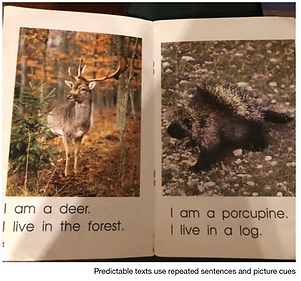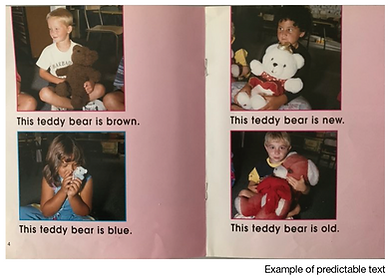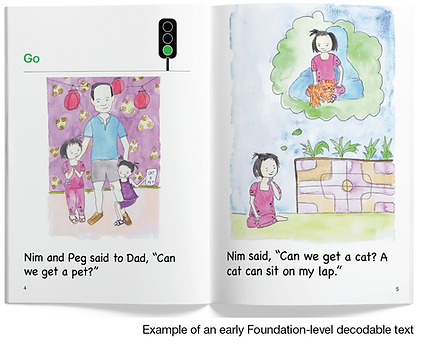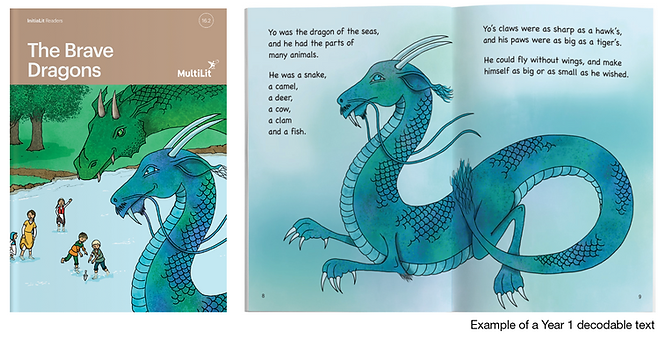Decodable or predictable: Why reading curriculum developers must seize one
Decodable or predictable: Why reading curriculum developers must seize one

Curriculum developers and teachers are grappling with the question of when to provide students with decodable and predictable texts, particularly alongside the teaching of systmatic synthetic phonics.
By Jennifer Buckingham
The draft revision of the Australian Curriculum was released for consultation in April and two aspects of the English F–6 curriculum attracted particularly strong criticism. One is the inclusion of a variation of the three-cueing strategy for reading. There are multiple references in the draft curriculum to students using ‘contextual, semantic, grammatical, and phonic knowledge’ (or some variation of this) to read words, and to use ‘text processing strategies’, which is another term for the same idea. As explained here, three-cueing with phonics as the strategy of last resort is not an effective, evidence-based reading strategy. It instils the habits of weak readers and therefore should not have been enshrined in the Australian Curriculum.
A second and related problem in the draft curriculum was the requirement that children read both decodable texts and predictable texts. These different types of texts are designed to encourage different reading strategies and therefore they contradict each other at a time when consistency is important.
Predictable texts are based on the same flawed premise as the three-cueing strategy – the idea that skilled reading involves prediction and guessing – whereas multiple scientific studies have shown that skilled readers process all of the letters in a word and that this becomes automatised through phonic decoding. Decodable books are designed to establish this skill.

While picture books with repetitive text structures are enjoyable and valuable for very young children before they begin formal reading instruction, and later as a shared text, they are not appropriate as classroom or home ‘readers’ for students to practise their own reading once they begin school.
One of the reasons that predictable texts keep rearing their ugly heads in curricula and syllabi comes from an apparent misunderstanding of what predictable texts are, and why they are detrimental to early reading development when used incorrectly. This misunderstanding extends from official documents, like the curriculum, through to teachers in schools.
A recently published study conducted in Western Australia found that more than half of the teachers surveyed gave both decodable and predictable texts to beginning readers, even though almost all teachers reported teaching systematic synthetic phonics in their literacy lessons. Students will become confused and frustrated if they are taught to use phonics in their lessons and when reading decodable texts, but are then also asked to guess words (or attempt to sound out with letter-sound patterns they haven’t yet learned), when reading predictable texts. It also demonstrates that many teachers are themselves unaware of the problems associated with using both types of texts together for instruction. By including both text types in the curriculum these problems will be exacerbated.
What are predictable texts?

Predictable texts are a specific type of book used in the earliest stages of reading instruction. Predictable texts are constructed to encourage beginning readers to memorise whole words and sentences and to use picture cues to ‘read’ unknown words. The texts have a repeated sentence or phrase on each page, typically with one variable word. A picture accompanies each sentence that allows the student to guess the variable word using the picture.
Predictable books do not follow a scope and sequence of any kind – phonic or otherwise. While the syntax and sentence structures in predictable books are simple, there is no systematic approach to the vocabulary included. Since predictable books are deliberately designed to preclude decoding using phonics, they contain words that students are unlikely to be able to decode in the first few terms of school, even if they were receiving high-quality phonics instruction – words like ‘porcupine’ and ‘forest’. They include words that are only able to be read by beginning readers, as either memorised whole words or guesses based on picture cues.
The predictable text pictured at the top of the page is written for children early in their Foundation year of school, but it contains two-syllable words with digraphs that would not be taught until Year 1 in most phonics sequences. In some cases, the pictures do not even provide a useful clue to the variable word, since the bears depicted could be described in any number of ways.
Not all books in sets of levelled readers that are common in schools are predictable texts. Some levelled readers are natural language texts with controlled vocabulary; that is, they are not written to be phonically decodable in alignment with a scope and sequence of grapheme-phoneme (letter-sound) correspondences, but a deliberately large proportion of the words in the text would be familiar vocabulary. This is intended to aid comprehension.
Students in the early years of school who make rapid progress in reading and who do not need the support of decodable texts should be given natural language books with appropriate complexity of language and content, rather than predictable texts. However, the process of assigning students to levels and limiting their access to books on that basis is not evidence-based practice. Non-predictable types of levelled readers should be treated like any other book in a class library.
Why are decodable texts better than predictable texts for beginning readers?

Decodable texts are written to align with a phonics scope and sequence. They begin with a limited number of grapheme-phoneme correspondences to establish facility with decoding and blending, and decodable book series progressively add more grapheme-phoneme correspondences as students learn them. A small number of high-frequency words that students would not yet be able to decode are included, and are taught as ‘tricky’ words, as these function words are necessary for meaningful sentences. Decodable texts have pictures to make reading enjoyable and to generate further discussion about the text, but students do not rely on the pictures for word identification.
The first levels of decodable books have simple syntax and a small number of words. Decodable texts at this level are sometimes criticised for being ‘boring’, but they are no more boring than predictable texts, as can be seen in the examples above. The difference is that decodable texts serve an essential instructional purpose – they establish student’s ability to decode and read words with accuracy and automaticity, which is the only way to achieve fluency and comprehension.

As students become more adept at decoding and can accurately read more words, the text becomes gradually more sophisticated. In the higher levels of decodable texts, both fiction and non-fiction decodable texts are virtually indistinguishable from simple natural language texts. However, they are still providing the necessary exposure to, and practice with, decoding words with a range of grapheme-phoneme correspondences from the basic through to the extended code. Eventually, when the students have mastered the full phonic code, all books are more or less decodable, but this is not true for novice readers who are just beginning their reading instruction.
Decodable texts support the development of strong decoding skills in beginning readers and provide them with the practice they need to become fluent readers. This is consistent with evidence-based methods of reading instruction. Predictable books are counterproductive to this objective.
Learn more about predictable vs decodable books
Read
‘Explainer: What’s the difference between decodable and predictable books, and when should they be used?’ Simmone Pogorzelski & Robyn Wheldall. The Conversation or Nomanis.
‘Decodable or predictable: Why reading curriculum developers must seize one.’ Simmone Pogorzelski, Susan Main & Janet Hunter. EduResearch Matters.
‘A survey of Western Australian teachers’ use of texts in supporting beginning readers.’ Simmone Pogorzelski, Susan Main & Susan Hill. Issues in Educational Research.
‘What do I do with all these predictable books?’ The Right to Read Project
Watch on YouTube
Tanya Serry comparing predictable and decodable texts.
Alison Clarke (Spelfabet) explaining the problem with predictable texts.
This article appeared in the Dec 2021 edition of Nomanis.
Dr Jennifer Buckingham [@buckingham_j on Twitter] is Director of Strategy and Senior Research Fellow at MultiLit.
Decodable or predictable: Why reading curriculum developers must seize one
Explainer: What’s the difference between decodable and predictable books & when should they be used?
Screen vs. paper: The effects of text medium on reading comprehension